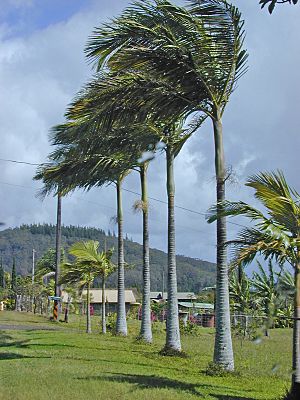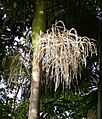Alexandra palm facts for kids
Quick facts for kids Alexandra palm |
|
|---|---|
 |
|
| Conservation status | |
|
Least Concern (NCA)
|
|
| Scientific classification | |
| Genus: |
Archontophoenix
|
| Species: |
alexandrae
|
The Archontophoenix alexandrae, also known as the Alexandra palm or king palm, is a type of palm. It grows naturally only in Queensland, Australia. This palm was named after Princess Alexandra of Denmark. Sometimes people mistakenly call it the Alexander palm, but its name honors a princess!
Contents
About the Alexandra Palm
The Alexandra palm is a tall, single-trunked palm. It can grow up to 30 meters (about 100 feet) high. Its trunk can be up to 30 centimeters (about 12 inches) wide. The trunk often looks a bit wider at the bottom. You can also see marks on the trunk where old leaves used to be.
This palm has a beautiful crown of 8 to 10 fronds. These fronds look like feathers. Each frond can be as long as 4.5 meters (about 15 feet). They have many small leaflets, usually 60 to 80 on each side. The top of the leaflets is dark green. The underside is a shiny silvery-grey. Each leaflet can be up to 75 centimeters (about 30 inches) long. The whole frond often has a slight twist.
At the bottom of each frond is a part called a crownshaft. This part is light green and can be up to 1 meter (about 3 feet) tall.
Palm Flowers
The flowers of the Alexandra palm grow in a large cluster. This cluster is called an inflorescence. When it first appears, it is creamy white. It grows inside a protective cover. As the fruits start to grow, the cluster turns light green. Finally, it turns brown and falls off the tree.
These flower clusters can be 50 to 100 centimeters (about 20 to 40 inches) wide. They also grow up to 50 centimeters (about 20 inches) long. They come out from the base of the crownshaft. Alexandra palms can flower at any time of the year. You might see some palms with flowers and fruit, while others have none.
The individual flowers are small and creamy-white. They have three petals. The male flowers are about 10 millimeters (0.4 inches) wide. The female flowers are even smaller, about 4 millimeters (0.16 inches) wide.
Palm Fruit
The fruits of the Alexandra palm are round or egg-shaped. They have a small, lasting cup-like part at their base. When they are young, they are green. As they ripen, they turn a bright red color.
Each fruit is about 10 to 14 millimeters (0.4 to 0.55 inches) across. Inside, there is one single seed. This seed is about 8 millimeters (0.3 inches) wide.
Where Alexandra Palms Grow
This palm grows naturally in north-east and central-east Queensland, Australia. You can find it from the Melville Range in Cape York Peninsula down to south of Gladstone. It grows from sea level up to 1,000 meters (about 3,300 feet) high.
You will most often see these palms in lowland rainforests near rivers and swamps. They often grow in places that get flooded a lot during heavy rains. They are very good at handling these wet conditions. This allows them to become the main type of tree in these areas.
Animals That Love Alexandra Palms
Many different birds love to eat the fruit of the Alexandra palm. The Metallic starling is one of them. These birds often arrive in a big group. They can eat all the ripe fruits on a tree in about an hour!
Other common birds that eat the fruit include the Torresian imperial pigeon and the Wompoo fruit dove. Fruit bats also enjoy these fruits. Even the Musky rat-kangaroo eats them.
Growing Alexandra Palms
It is easy to grow new Alexandra palms from fresh seeds. This palm is very popular in Australia. People plant it in their gardens, on streets, and in parks. It grows quickly. It can even grow in cooler places outside of the tropics, as long as there is no frost.
The Alexandra palm has been planted in many countries around the world. It has even started to grow naturally in Hawaii.
How the Palm Got Its Name
The Alexandra palm was first described as Ptychosperma alexandrae in 1865. This was done by a scientist named Ferdinand von Mueller. Later, in 1875, two German botanists, Hermann Wendland and Oscar Drude, gave it its current name, Archontophoenix alexandrae.
The name of the genus, Archontophoenix, comes from two old Greek words. Árkhōn means "chieftain" or "ruler." Phoenix is another type of palm. This name was chosen because the palm trees look very grand and regal. The second part of the name, alexandrae, honors Princess Alexandra of Denmark.
Images for kids
See also
 In Spanish: Palma alejandra para niños
In Spanish: Palma alejandra para niños








